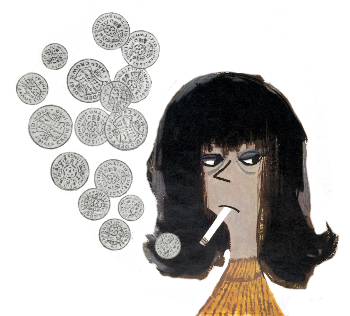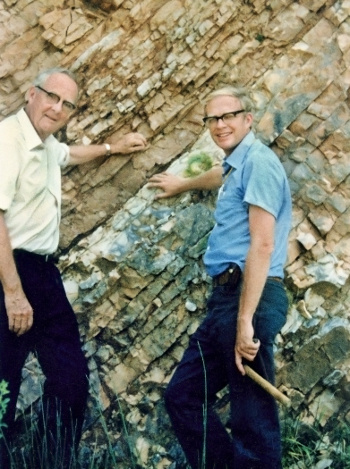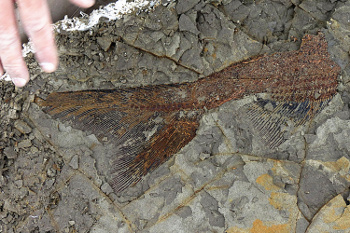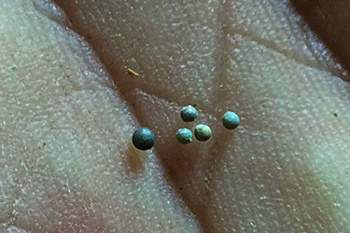The Tanis Deposit
May 6, 2019
Jokes are only
funny when they don't need to be explained. While a
physicist will realize that a
cat will fall from a
roof if his
mew is too small, he will get no
laughs from a listener who doesn't know that the
coefficient of friction is always
symbolized by
mu (μ). That's why
Gary Larson's Far Side cartoon about
dinosaur extinction is memorable. This cartoon, which shows
dinosaurs smoking cigarettes, is funny because it's common knowledge that dinosaur extinction was caused by a
meteor impact, perhaps aided by concurrent factors that don't include cigarette smoking.

As this cartoon illustrates, smoking causes a financial burden as well as a health burden.
Governments have a financial interest in smoking cessation, since much of the expense of smoking-related health problems fall on them. One way governments discourage smoking, and also recoup health-related expenses, is through a cigarette tax. New York State is especially aggressive in this regard, having a cigarette tax of $4.35 per pack of twenty.
George Harrison (1943-2001) of The Beatles had many health-related issues arising from smoking. These included throat cancer and lung cancer.
One reason that cigarettes are packed as twenty items is the efficient stacking of 7, 6, and 7 cylinders. Matchbooks also contain twenty matches for the same reason, but it's unlucky to light three cigarettes from the same match.
(Portion of Wellcome Trust Photo no. L0024904, Library ref., ICV No 51428, by Reginald Mount, via Wikimedia Commons. Click for larger image.)
The
Earth is constantly bombarded by
meteors, but spectacular
meteor impacts like the June 30, 1908,
Tunguska impact and the more recent February 15, 2013,
Chelyabinsk meteor[1] happen infrequently. The Tunguska event had an estimated
blast-equivalent of 10
megatons of
TNT, while the Chelyabinsk event had a much smaller
energy of half a megaton. An average of 5-10
grain of sand sized meteors hit the Earth each hour, and this number can increase to hundreds an hour during
meteor showers.
A
kilogram meteor finds its way to earth about every year, a Tunguska-sized meteor hits about every
century, and an
extinction level impact of 50
gigatons happens a few times every million years. A real
blockbuster meteor can be expected on a hundred million year time scale. Ninety percent of all
species were killed off by the likely
impact of a huge meteor about 250 million years ago, marked in the geological record at the
Permian-Triassic boundary. A similar and more recent event at the
Cretaceous-Tertiary was responsible for the extinction of the dinosaurs and the rise of
mammals about 65 million years ago.
The link between meteors and extinction was found in 1980 by
physicist,
Luis Avlarez, his
planetary scientist son,
Walter Alvarez (b. 1940), and their colleagues,
Frank Asaro (1927-2014) and
Helen Michel (b. 1932).[2-3] Luis Alvarez is known also as the recipient of the 1968
Nobel Prize in Physics for his work in
elementary particle physics.

Luis Alvarez (left) and his son, Walter.
Luis Alvarez was awarded the 1968 Nobel Prize in Physics for his development of the liquid hydrogen bubble chamber, a device for visualizing elementary particles. In this device, liquid hydrogen is held in a superheated state for a few seconds, and passage of an energetic particle produces a track of hydrogen bubbles.
This invention builds from the original bubble chamber idea of Donald Glaser (1926-2013), who was awarded the 1960 Nobel Prize in Physics.
(Lawrence Berkeley Laboratory photograph, via Wikipedia))
This discovery happened during analysis of the
clay layer that marks the
end of the Cretaceous Period.
Iridium is a rare
element in
Earth's crust, existing as just 0.001
ppm by
weight, which is forty times less of an abundance than
gold. However, their analysis of this clay layer showed a concentration that was two
orders of magnitude greater than expected.
Earth's crust accrues iridium from the infall of
micrometeorites, diluted over Earth's large
surface area, so this larger concentration was supposed to come from a large extraterrestrial source. This excess of iridium is believed to have come from the impact of a 10-15
kilometer (6-9
mile)
diameter asteroid at
Chicxulub crater, which is centered on
Chicxulub, Yucatán,
Mexico. The remnant of this crater is 150
kilometers (93
miles) in
diameter and 20 km (12 miles) deep. Such an impact was a major
natural disaster, enough to have caused most
species living at the time to become
extinct.

The Chicxulub impact crater is located in the northwest corner of Mexico's Yucatán Peninsula. On the left is a shaded relief image of the area showing the barest outline of the remnant of the circular crater. The right image is the same area viewed by the Landsat satellite showing vegetation cover that highlights the region. The central white spot with no vegetation is the city of Merida. (NASA images (PIA03381), February, 2000, via Wikimedia Commons)
As a recent study has shown, there's more direct evidence that a meteor impact caused of the Cretaceous-Tertiary extinction than an enrichment of iridium or the outline of the Chicxulub impact crater.[4-7] Meteor impact generated a
tsunami-like wave in an
inland sea of what's now
North America, and this tsunami killed numerous species whose remains were quickly buried by
sediment and subsequently
fossilized in a high state of preservation.[5]
This
fossil trove is described in a recent issue of the
Proceedings of the National Academy of Sciences by a team of
geologists and
paleontologists from the
University of California (Berkeley, California), the
University of Kansas (Lawrence, Kansas),
Vrije Universiteit (Brussels,Belgium),
University of Manchester (Manchester, UK),
Florida Atlantic University (Boca Raton, Florida), the
Black Hills Institute of Geological Research (Hill City, South Dakota),
Florida International University (Miami, Florida), the
Katholieke Universiteit Leuven (Leuven, Belgium), and the
Palm Beach Museum of Natural History (Fort Lauderdale, Florida).[4] The
research team included Walter Alvarez, who discovered the iridium anomaly of this extinction event in 1980.[5]
The fossil site, called Tanis, is a 1-1/2
meter thickness layer that's located in
North Dakota's Hell Creek Formation.[5-6] In this layer. fossilized
fish are stacked one atop another along with fossilized
vegetation,
insects,
mammals, dinosaurs,
ammonites, and other
animals. It's a huge collection of different species of different stages of life that died at the same time, on the same day.[5] The fossil preservation is superb because of the quick formation of the sediment layer.[6]

A fish tail fossil from the Tanis deposit.
The excellent condition of this fossil is a consequence of the unusually rapid burial of species by sediment.
(University of California, Berkeley, image.[5])
The
conjectured mechanism for such fossilization was a violent shaking that created a 30 foot wave on the inland sea in what is now North Dakota, and this wave deposited fish onto a
sand bar at the mouth of a
river.[5] The wave then reversed direction and left the fish stranded, at which time the fish were pelted with
tektites,
glass beads up to 5
millimeter in diameter, that
condensed from
molten material ejected by the meteor impact into the
atmosphere.[5] This torrent of ejecta lasted for 10-20 minutes, and then a second large wave covered the fish with sediment, where they fossilized.[5] Says paleontologist,
Robert DePalma, an
author of the paper and discoverer this fossil deposit,
"A tsunami would have taken at least 17 or more hours to reach the site from the crater, but seismic waves - and a subsequent surge - would have reached it in tens of minutes."[6]
While the Chicxulub impact did create tsunamis, the wave in the inland sea was not a tsunami, but a
seiche, a
standing wave caused by an
earthquake.[5] A tsunami would have taken 10-12 hours to travel the 3,000 kilometers from the impact site, while the exposure of the fish by a seiche would have occurred at the same time as the rain of tektites.[5] Such seiches have been observed in recent times. The 2011, 9.0
magnitude,
Tohoku earthquake in
Japan created a six-foot-high seiche half an hour later in a
Norwegian fjord 8,000 kilometers (5,000 miles) away.[5-6]
The tektites would have impacted at speeds of 100-200
miles per hour, and it's suspected that the rain of tektites and other debris would have ignited
wildfires over the
Americas; and, perhaps, around the world.[5] Tektites were discovered, also, in the
gills of fossil
Acipenseriforma (
sturgeons and
paddlefish) that
swam through the water with their
mouths open as they were
feeding.[5-6] The fossil bed also produced evidence of some undiscovered species of fish. Says DePalma "“At least several appear to be new species, and the others are the best examples known of their kind... Before now, fewer than four were known from the Hell Creek, so the site was already magnificently significant."[6]

1 millimeter glass tektites recovered from the Tanis fossil bed.
(University of California, Berkeley, image.[5])
![]()
References:
- Meteor Hits Russia Feb 15, 2013 - Event Archive, YouTube Video, February 18, 2013.
- Luis W. Alvarez, Walter Alvarez, Frank Asaro, and Helen V. Michel, "Extraterrestrial Cause for the Cretaceous-Tertiary Extinction," Science, vol. 208, no. 4448 (June 6, 1980), pp. 1095-1108, DOI: 10.1126/science.208.4448.1095. A PDF copy of this paper can be found here.
- Luis W. Alvarez, "Experimental evidence that an asteroid impact led to the extinction of many species 65 million years ago," Proc. Natl. Acad. Sci., vol. 80, no. 2 (January 15, 1983), pp. 627-642. A PDF copy of this paper can be found here.
- Robert A. DePalma, Jan Smit, David A. Burnham, Klaudia Kuiper, Phillip L. Manning, Anton Oleinik, Peter Larson, Florentin J. Maurrasse, Johan Vellekoop, Mark A. Richards, Loren Gurche, and Walter Alvarez, "A seismically induced onshore surge deposit at the KPg boundary, North Dakota," Proceedings of the National Academy of Sciences, Advanced Publication, https://doi.org/10.1073/pnas.1817407116. This open access article is distributed under the Creative Commons Attribution License 4.0(CC BY) with a PDF file https://www.pnas.org/content/pnas/early/2019/03/27/1817407116.full.pdf.
- Robert Sanders, "66 million-year-old deathbed linked to dinosaur-killing meteor," University of California, Berkeley, Press Release, March 29, 2019.
- Stunning discovery offers glimpse of minutes following ‘dinosaur-killer’ Chicxulub impact, University of Kansas Press Release, March 29, 2019.
- Robert DePalma excavating at the Tanis fossil site in North Dakota, YouTube Video, March 29, 2019.
Linked Keywords: Joke; humour; funny; physicist; cat; roof; laughter; laugh; coefficient of friction; symbol; symbolize; mu (letter, μ); Gary Larson; The Far Side; cartoon; dinosaur; extinction; smoking; cigarette; meteor impact; "Financial cost of cigarette smoking (cartoon); cartoon; finance; financial; health; government; smoking cessation; expense; cigarette tax; New York State; cigarette pack; George Harrison (1943-2001); The Beatles; throat cancer; lung cancer; relative density; efficient stacking; cylinder (geometry); matchbook; luck; unlucky; Wellcome Trust Photo; Reginald Mount; Wikimedia Commons; Earth; meteorite; meteor; Tunguska event; Chelyabinsk meteor; TNT equivalent; blast-equivalent; ton; megaton; TNT; energy; grain of sand; meteor shower; kilogram; century; extinction event; gigaton; blockbuster; species; Permian-Triassic extinction event; impact of a huge meteor; Permian-Triassic boundary; Cretaceous-Tertiary extinction event; mammal; Luis Avlarez; planetary science; planetary scientist; Walter Alvarez (b. 1940); Frank Asaro (1927-2014); Helen Michel (b. 1932); Nobel Prize in Physics; elementary particle physics; liquid hydrogen; bubble chamber; elementary particle; superheating; superheated; energy; energetic; hydrogen; bubble (physics); invention; Donald Glaser (1926-2013); Lawrence Berkeley Laboratory photograph; clay; iridium; chemical element; Earth; crust (geology); parts-per notation; ppm; weight; gold; order of magnitude; micrometeoroid; micrometeorite; surface area; kilometer; mile; diameter; asteroid; Chicxulub crater; Chicxulub, Yucatán; Mexico; natural disaster; species; extinction; extinct; northwest; Mexico; Yucatán Peninsula; terrain cartography; shaded relief image; Landsat satellite; vegetation; city of Merida, Mexico; tsunami; surface wave; inland sea (geology); North America; sediment; fossil; fossilize; Proceedings of the National Academy of Sciences; geologist; paleontologist; University of California (Berkeley, California); University of Kansas (Lawrence, Kansas); Vrije Universiteit (Brussels,Belgium); University of Manchester (Manchester, UK); Florida Atlantic University (Boca Raton, Florida); Black Hills Institute of Geological Research (Hill City, South Dakota); Florida International University (Miami, Florida); Katholieke Universiteit Leuven (Leuven, Belgium); Palm Beach Museum of Natural History (Fort Lauderdale, Florida); research; meter; North Dakota; Hell Creek Formation; fish; insect; mammal; Ammonoidea; ammonite; animal; fish; tail; conjecture; conjectured; shoal; sand bar; river; tektite; glass; bead; millimeter; condensation; condense; melting; molten; material; atmosphere of Earth; Robert DePalma; author; seismic wave; seiche; standing wave; earthquake; seismic magnitude scale; Tohoku earthquake; Japan; Norway; Norwegian; fjord; miles per hour; wildfire; Americas; gill; Acipenseriformes; sturgeon; paddlefish; aquatic locomotion; swim; mouth; eating; feeding.